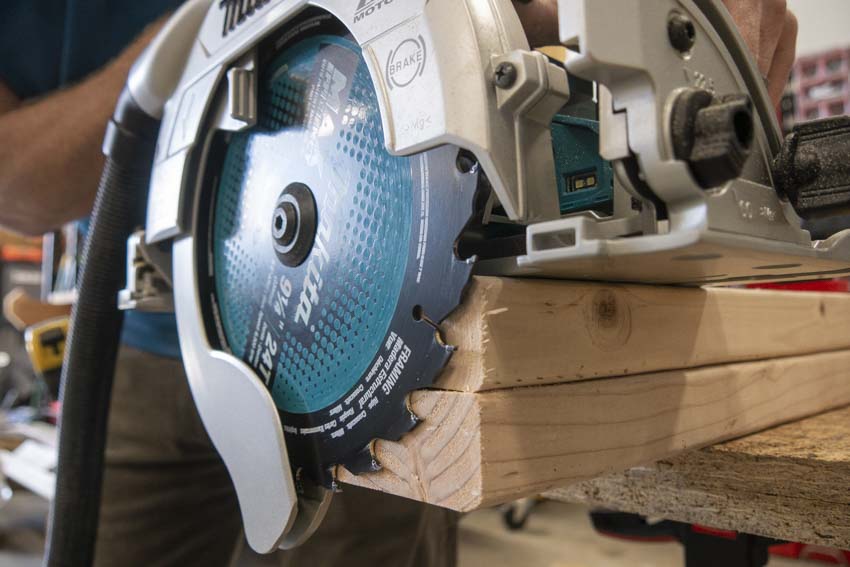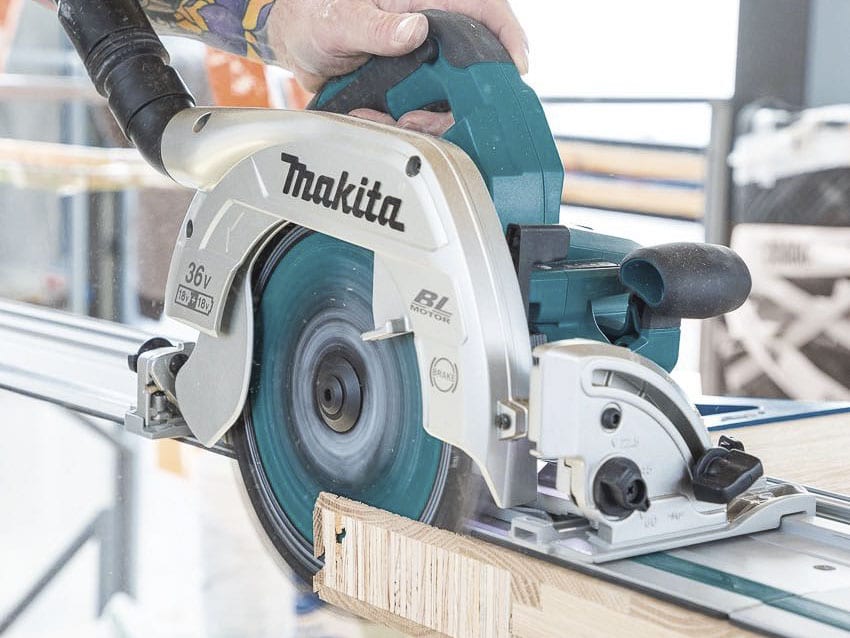Do you ever wonder if a circular saw cuts up or down? Well, let’s dive into the world of power tools and find out!
When it comes to using a circular saw, understanding the correct cutting direction is crucial for safety and efficiency. So, in this article, we’ll discuss whether a circular saw cuts up or down, and provide you with all the information you need to know.
Whether you’re a beginner or a seasoned DIY enthusiast, this article will clarify any confusion and help you confidently handle a circular saw. So, let’s get started and unravel the mystery behind the cutting direction of a circular saw!

Does a Circular Saw Cut Up or Down?
Circular saws are versatile and powerful tools commonly used in woodworking and construction projects. One common question that arises when using a circular saw is whether it cuts up or down. In this article, we will explore the correct way to use a circular saw and how it cuts through materials.
Understanding the Circular Saw Blade
The blade of a circular saw is designed with a set of teeth that rotate rapidly to cut through various materials. The direction of the teeth’s rotation determines the direction of the cut. In most circular saws, the blade rotates clockwise, which means it cuts in an upward direction when held properly. This upward cutting motion helps to prevent the material from splintering and ensures cleaner and more precise cuts.
When using a circular saw, it is important to position the material in a way that allows the blade to cut in an upward direction. This means that the material should be placed with the face that needs to be cut facing downwards. By cutting in an upward direction, the teeth of the blade push against the material, reducing the likelihood of chipping or splintering.
Proper Technique for Using a Circular Saw
When operating a circular saw, it is crucial to follow the correct technique to ensure safety and achieve the desired results. Here are the steps to properly use a circular saw:
- Wear appropriate safety gear, including safety glasses, ear protection, and gloves.
- Position the material to be cut on a stable surface, making sure it is supported and secure.
- Mark the desired cut line on the material using a pencil or a straight edge.
- Ensure that the blade is set to the correct depth for the material being cut.
- Adjust the cutting angle, if necessary, for angled cuts.
- Hold the saw with both hands, firmly gripping the handle and the auxiliary handle for stability.
- Align the blade with the marked cut line.
- Start the saw and let the blade reach full speed before making contact with the material.
- Gently guide the saw along the cut line, maintaining control and applying consistent pressure.
- Continue cutting until the blade completely passes through the material.
- Release the power trigger and wait for the blade to come to a complete stop before setting the saw down.
By following these steps and ensuring the proper orientation of the material, you can achieve accurate and clean cuts with a circular saw.
Benefits of Cutting Up with a Circular Saw
Cutting up with a circular saw offers several benefits, including:
- Reduced splintering: Cutting up helps to minimize splintering and chipping, resulting in cleaner cuts.
- Better visibility: When cutting up, you have a clear view of the cut line, making it easier to achieve precision.
- Improved control: The upward cutting motion allows for better control and stability while cutting through the material.
- Safe operation: By following the recommended cutting direction, you can ensure safer operation and minimize the risk of accidents.
Tips for Using a Circular Saw
To enhance your experience and achieve optimal results when using a circular saw, consider the following tips:
- Use a sharp blade: A sharp blade will cut more efficiently and reduce the chances of kickback.
- Secure the material firmly: Make sure the material is properly supported and secured to prevent it from shifting during the cut.
- Take breaks when needed: Cutting for extended periods can cause fatigue, so take breaks to avoid compromising your safety and accuracy.
- Practice on scrap materials: If you are new to using a circular saw, practice on scrap materials first to gain confidence and improve your skills.
- Follow the manufacturer’s instructions: Always refer to the user manual provided by the manufacturer for specific guidelines and safety precautions.
Conclusion
Using a circular saw involves cutting in an upward direction to achieve cleaner and more precise cuts. By understanding the proper technique and following safety precautions, you can make the most of this versatile tool. Remember to wear appropriate safety gear, position the material correctly, and maintain control throughout the cutting process. With practice and adherence to the guidelines outlined in this article, you can confidently use a circular saw to tackle your woodworking and construction projects.
Key Takeaways: Does a Circular Saw Cut Up or Down?
- A circular saw cuts downwards into the material.
- Always position the saw blade below the material being cut.
- The teeth on the bottom of the blade are what do the cutting.
- Make sure the material is properly supported to prevent accidents.
- Use caution and wear appropriate safety equipment when using a circular saw.
Frequently Asked Questions
When it comes to using a circular saw, there are often questions about which way to cut—up or down. Here are some commonly asked questions on the topic:
1. Do I cut with a circular saw by pushing it up or pulling it down?
When using a circular saw, you want to cut by pushing it forward in a controlled manner. The cutting action primarily occurs on the forward motion of the saw, known as the “down” direction. As you move the saw forward, the spinning blade makes contact with the material and cuts through it. Remember to maintain a firm grip on the saw and follow safety guidelines for a smooth cutting operation.
It’s important to note that the terms “up” and “down” refer to the orientation of the saw blade in relation to the material being cut, rather than the physical motion of the saw itself. So, to cut effectively with a circular saw, push it forward, allowing the downward motion of the blade to cut through the material.
2. Can a circular saw cut through materials when pulling it upwards?
While it is technically possible to cut through materials by pulling the circular saw upwards, it is not recommended for most cutting applications. Pulling the saw upwards can result in a less controlled and potentially dangerous cutting motion. Additionally, the design and tooth orientation of circular saw blades are optimized for the downward cutting action.
By pulling the saw up, you risk the blade being deflected or losing control, which can lead to uneven cuts or accidents. It’s best to follow the manufacturer’s guidelines and cutting techniques specific to circular saws, which involve pushing the saw forward for a cleaner and safer cut.
3. Do I have to adjust the circular saw’s blade orientation to cut in different directions?
No, you do not need to adjust the blade orientation of a circular saw to cut in different directions. Circular saw blades are designed to cut in a specific direction, primarily downwards. The teeth of the blade are angled and aligned to maximize cutting efficiency in the downward motion.
Changing the blade orientation to cut in different directions may result in less effective cutting performance and can potentially damage the saw or material being cut. It is recommended to use proper cutting techniques by pushing the saw forward for appropriate cutting action.
4. Is it possible to cut upwards with a circular saw in certain situations?
While cutting upwards with a circular saw is generally not recommended, there might be certain situations where it can be necessary or beneficial. One such example is plunge cutting, where you need to start the cut in the middle of a material rather than at the edge.
For plunge cuts, the circular saw blade is positioned on the material’s surface, and then the saw is pushed forward to start the cut. While this might involve a slight upward motion, the primary cutting action still occurs on the downward movement of the saw. It’s important to exercise caution and follow proper techniques when attempting plunge cuts or any unconventional cutting methods.
5. Are there any safety precautions I should take when using a circular saw?
Absolutely! When using a circular saw or any power tool, safety should always be a top priority. Here are a few key safety precautions to keep in mind:
– Always wear appropriate safety gear, including safety glasses, ear protection, and a dust mask if necessary.
– Ensure the blade is securely attached and properly adjusted before starting any cutting tasks.
– Keep your hands away from the blade and maintain a firm grip on the saw throughout the cutting process.
– Use a sawhorse or a stable work surface to support the material being cut.
– Keep bystanders at a safe distance and be aware of your surroundings.
– Familiarize yourself with the user manual and follow all safety guidelines provided by the manufacturer.
By following these safety precautions, you can minimize the risk of accidents and ensure a safe and successful cutting experience with your circular saw.

Summary
So, does a circular saw cut up or down? It actually cuts down. The circular blade spins clockwise, which means the teeth on the blade push the wood down when cutting. Remember to always wear safety gear and follow proper procedures when using a circular saw to ensure a safe and accurate cut.
